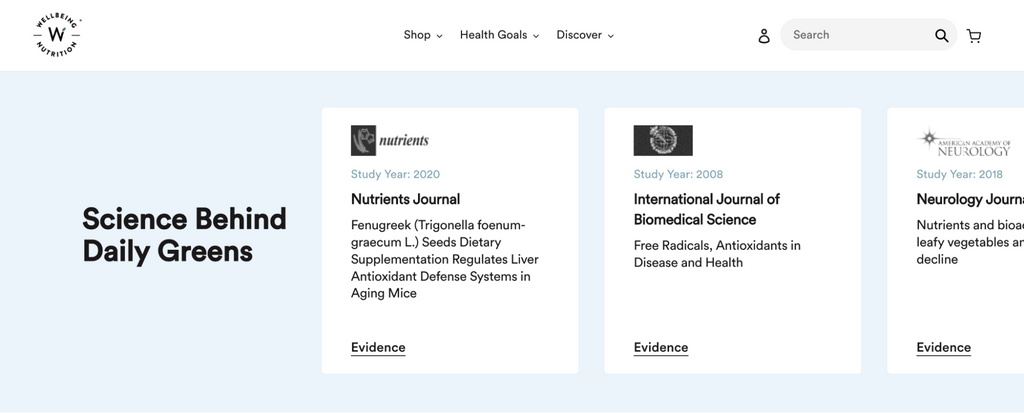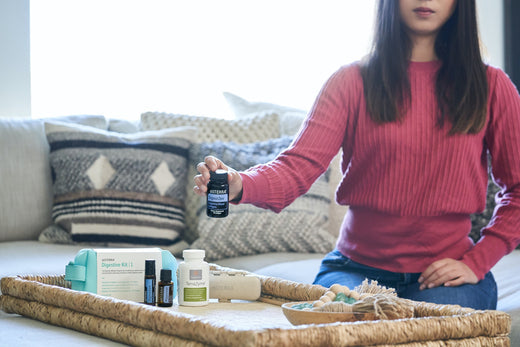Learn from the best health and wellness Shopify stores, the hack to product page optimization.
Continuing on our health and wellness series, where we share various tried and tested design tips to help take your online brand to new heights, we’ve created a list of eCommerce product page strategies that you need to implement in your health and wellness Shopify website.
After all, it’s the product page that eventually leads to a consumer making an informed purchase decision!
If you missed our first post in this series, you can read it here: Must-Haves On Your Health And Wellness Online Store Home Page.
PS. All the following tips can be implemented on most health and wellness Shopify themes using customizations.
Product page must-haves on a health and wellness Shopify store
There’s no one-strategy-fits-all approach to designing product pages. Your strategy should entirely depend on the type of products you sell, who your target audience is, what your ideal customer persona looks like and what can help them make informed purchase decisions on aspects as sensitive as their health.
But here's what we have observed on the best health and wellness Shopify stores:
1. Clear product pictures (with nutrition facts)
When shopping online, consumers are bound to be skeptical about any purchase. To aid in their decision journey, it is crucial to use high-quality product photos. Prioritizing your eCommerce product photography will help you boost your conversion rates seamlessly.
Over 90% of online shoppers believe that product photo quality is the most important factor in the eCommerce sphere. In fact, 75% of them base their purchase decisions on the product shots used.
Furthermore, health and wellness Shopify stores should also have a dedicated nutrition facts section if your product requires it. The idea is to provide your user with all the necessary information to help them make an informed purchase decision.
Here’s an example of how Superfeet combines good product photography with benefits added to the visuals on their Shopify product page:

2. Summary of product ratings
The best eCommerce product pages have even the tiniest UI/UX elements executed after a thorough understanding of consumer psychology. It's usually the little things that add up to the overall likeability of your online store.
For instance, adding a summary of the available product/service ratings just below the product name helps the user make quicker, better, and well-informed decisions. It saves them time and effort of having to sift through many reviews. This is a strategy that Amazon has been playing on for years and now leading brands on Shopify are too!
Here’s an example from Cosmix Shopify product page:

And one from Jacked Factory, an online store that sells health supplements:

3. Detailed and honest product descriptions
40% of millennials claim that product content is very important to their purchasing decisions. In fact, 98% of shoppers have been dissuaded from completing a purchase because of incomplete or incorrect product specifications.
If you’re a health and wellness product brand, this is going to be one of the most important sections of your product page. Provide detailed information about the ingredients, benefits, and a general overview of the product.
Consumers of today demand transparency from brands. They want to have access to information about the products that they are utilizing; so make sure you keep the descriptions crisp and clear.
Here’s an example from Binto, a personalized supplement brand:

In fact, even Jacked Factory keeps the description of its products in the first fold to keep things clear from the get-go:

4. Separate out the ingredients section
No matter how well you craft your product description, health and wellness product ingredients need to be mentioned separately. This is important because people do read the fine print when making purchases related to their health and wellness.
This also helps you deliver your value proposition in a different light, showing what goes ‘in’ the products that make them so good for someone’s health.
Here’s an example from the product page of Welly, a health and wellness brand with a focus on products for better sleep:

5. Option to subscribe for the product
About 15% of online shoppers have subscribed to an eCommerce subscription service within the past year. The main reasons to do so are convenience, personalized experience, and value for money.
And unlike other domains of eCommerce, health and wellness brands require a longer commitment with the brand to see effective results. This means that consumers will have to keep coming back to you to re-purchase/renew a particular product and/or service.
You can improve the UX of your store by adding a subscription model option. Simply automating the restocking/renewing process will help the consumer tremendously. Add a simple bright-colored button next to the Add To Cart button and you’re good to go!

Here’s another example from that of Goli’s website:

It’s also a great way to secure recurring sales and revenue for your health and wellness brand, helping you grow sustainably in a competitive market.
6. Include a how-to section
Giving full information about any product is critical. It lets the user analyze and make informed decisions, and understand if the item in consideration is as easy to use as they’d like it to be. That’s why we recommend creating a separate how-to section on your product pages altogether.
Take a look at the pictorial representation of this section by Oziva, India's leading clean, plant-based wellness brand:

Here’s another example from a health and wellness supplements brand, Wellbeing Nutrition:

7. Share and set product expectations
Consumers reach out to health and wellness brands with certain goals in mind; they expect a specific result.
And so, it is important to let shoppers know what your product and/or service can help them in their wellness journey. Ensure to keep this section as comprehensive and persuasive as possible. Talk about the impact the product has on the body over 1 month, 3 months, or 6 months - whatever suits your product range. Take it a notch higher and add pictures to show actual transformation journeys. It aids in helping the shopper make purchase decisions faster.
Here’s an example from Man Matters, a men’s wellness brand in India:

8. Display product recommendations
Prompt shoppers to explore your catalog by suggesting other products and/or services to try out that will complement and help them achieve better results (faster). This is your opportunity to upsell and cross-sell.
Personalization is the future of eCommerce. In fact, over 71% of consumers feel frustrated when a shopping experience is not customized according to their journey.
Your eCommerce product page design should try and incorporate Artificial Intelligence (AI) to boost the overall User Experience (UX) of your website. Product recommendations are a great start to leverage the power of AI and increase your conversion rate. Over 91% of customers claim that they are more likely to shop from stores that give personalized offers and recommendations.
Here’s how Yogamere does it:

Another good example comes from the website of Wellbeing Nutrition, combining products that address the same consumer concerns:

We’d also like to add Jacked Factory’s example here because they go one step ahead while displaying product recommendations. Instead of a generic heading to the section, they use the language of their ideal customers - ‘stack’ to give them a nudge:

Displaying product recommendations is a great way to improve your product discovery, upsell and cross-sell products on the site, keeping consumer intent in mind.
9. Share and link to related resources
Providing consumers with a few handy resourceful contents can instantly improve a user’s buying journey. These could include blogs, and/or YouTube videos. Placing a dedicated section of this on the product page is a great persuasive design integration.
The Woman’s Company, a women’s intimate hygiene brand has a belt of blog resources on all their product pages to help educate their consumers on the pressing matters of women’s health and wellness.

If you’re not creating content on your website as a part of the marketing strategy, you can also link out to reliable resources related to the industry like Wellbeing Nutrition does:

10. Add frequently asked questions (FAQs)
While shopping online, it is natural to have a lot of queries regarding the product and/or service on sale. Make it easier for your consumers by adding a dedicated section answering all the Frequently Asked Questions (FAQs).
Here’s a screenshot from the Love Wellness product page:

Here’s another example of displaying frequently asked questions from the Wellbeing Nutrition website:

The good thing is that adding FAQs to your product pages can also help improve the search engine optimization of the page. It lets you tackle long tail keywords to rank for more specific consumer queries.
Although we do recommend using a collapsible format for FAQs to keep your product page length optimized.
11. Include social proof
Social proof can massively impact a consumer’s purchase decision. To put this into perspective, check this out - Product pages with customer reviews enjoy 3.5 times more conversions than those without.
Add a dedicated section to share what your other customers think about your brand. Here’s how The Good Thing executes this. This section is usually placed at the end just above the footer.

If you want to one-up your social proof, enable your customers to submit product pictures and videos alongside their reviews. Visuals have a greater impact on the human brain, helping you deliver your product value proposition in a better way. Here’s an example of the same:

12. Easy-to-find contact and support information
Consumers, generally will have very specific concerns, requirements or queries related to the product or service they are interested in and this is especially true in the health and wellness industry. Your brand’s success hence heavily depends on how accessible your customer support is.
Therefore, easy access to contact or support information is crucial to giving customers what they want. It is a way to reassure them, build trust and softly direct customers towards purchase without any hindrance.
You can incorporate contact or support options such as live chat, phone support and email on your product page. A competent chatbot integration is also an effective way to handle frequent queries or provide preliminary support before directing customers towards your human agents. Brands like Olly offer a chat bubble on every page of their website to provide this easy accessibility.

13. Clear return and refund policy
Consumers in the health and wellness industry are always on the edge regarding product effectiveness, and a clear return and refund policy is necessary to alleviate this anxiety of perceived risks from purchasing the product.
Therefore, have a clear concise section on the product page, where the return and refund policies are directly stated, to nurture customer trust in your product and brand. Be sure to emphasize important details such as the return window, terms, and how to return or exchange things. Additionally, strategies such as a money-back guarantee are a great way to entice first-time customers.
Here is a good example from Ritual:

14. Detailed shipping information
Another key element that can greatly enhance the user experience form your health and wellness website is clear information on shipping, cost, delivery times and tracking options. Consumers often expect prompt delivery in the health and wellness sector and by conveying all the shipping information in a dedicated section on the product page, you can set realistic expectations, and eliminate anxiety.
Add delivery ETAs based on customer location, product availability, etc., as well as provide options for tracking, to make for a more transparent, worry-free experience.
Here is how Bulletproof does this:

15. Highlight certifications and trust badges
Trust is a cornerstone for all brands but in the health and wellness industry, it is paramount. As customers do not wish to compromise in any way when it comes to their health, it is important to reassure customers with trust badges, certifications or other forms of credibility markers like FDA approval, organic certification etc.
All of these can convey to the customer the quality and safety standards of your products. In a survey conducted by Econsultancy, 48% of customers were of the opinion that trust badges reassured them about the trustworthiness and security of a website.
Keep in mind that these badges should be prominent and appear close to the product to have the maximum impact. Here is a great example from Hum Nutrition:

Conclusion
Setting up a high-converting health and wellness store design can get tricky. To build and design an impressive store, you need to work with Shopify design experts who understand what you are looking for and have the industry knowledge of the changing trends and consumer preferences.
Also read: Why Your Shopify Store Design Is Important to Increase Conversion Rates
We help you bring your ideas to life with Shopify web design, development, marketing, and support services from experts.
Our team of Shopify experts works with Shopify merchants like you to design the store that reflects the personality of your brand and caters to the functionalities you require. Whether you want to revamp your existing design or build a new one from scratch, we will help you create a positive shopping experience on your Shopify store design.
Reach out to us at info@xgentech.net and we’ll help you set up your Shopify store design and implement these health and wellness website tips to get more conversions.
We're working with some leading Shopify and Shopify Plus brands to help them design a great online experience for their customers. If you are a health and wellness brand looking for more design inspiration, do explore these brands:
Learn more about our Shopify experts for health and wellness brands here.
From the vast wealth of experience and expertise we have gained from working closely with hundreds of global wellness brands, we have been able to effectively craft tailor-made websites that utilize the finest Shopify themes and industry-standard techniques.
Xgentech provides you with expert services ranging from Shopify web design, customized Shopify development, eCommerce marketing strategizing, and effective store speed optimization, to help you build enhanced, seamless and high-quality user experiences.
Avail our expertise to create your ultra-efficient Shopify store!




